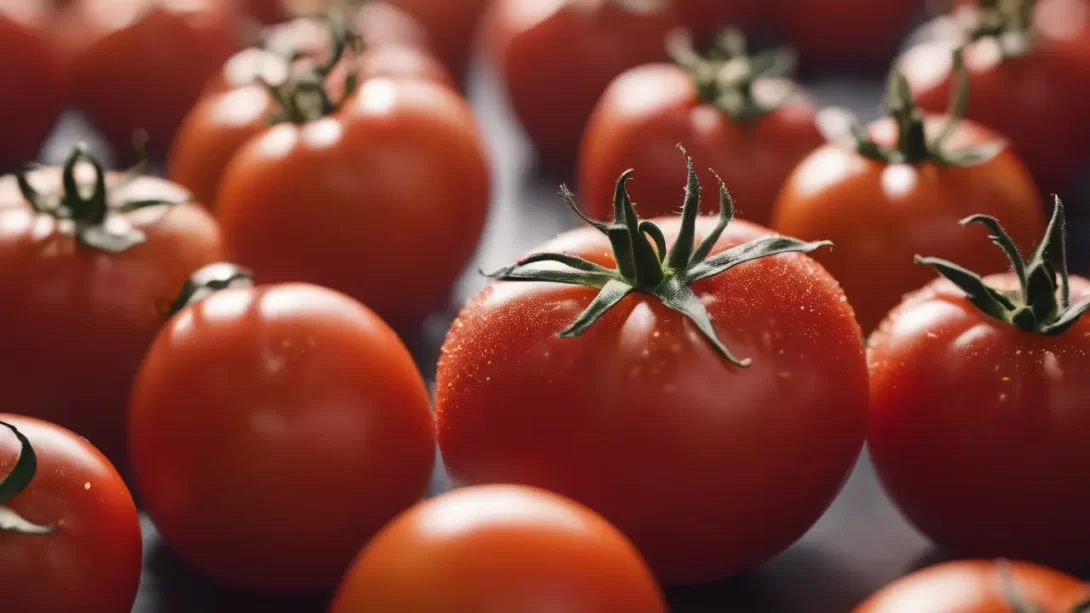Recognizing when tomatoes have gone bad is a crucial skill for anyone who cooks or enjoys fresh produce. Consuming spoiled tomatoes can lead to foodborne illnesses, making it important to identify signs of spoilage. This guide will provide you with the necessary information to determine whether your tomatoes are still good to eat or if they should be discarded.
Visual Signs of Spoilage in Tomatoes
The first step in determining if a tomato is bad is to examine its appearance. Look for:
- Mold: White, green, or black fuzzy spots on the surface are clear indicators of mold. Mold can develop on the skin or at the stem and is a sign that the tomato should be thrown away.
- Discoloration: Tomatoes should have a uniform color, which can range from deep red to orange and yellow, depending on the variety. If you notice significant discoloration, like dark spots or patches, it’s a sign of spoilage.
- Skin Blemishes: While minor blemishes don’t necessarily mean a tomato is bad, large bruises or deep cracks, especially those oozing liquid, can indicate internal spoilage.
Textural Indicators of Spoiled Tomatoes
After a visual inspection, the next step is to assess the texture.
- Soft Spots: It’s normal for tomatoes to get softer as they ripen, but overly soft or mushy spots often signal decay. Gently squeeze the tomato; if it feels mushy or if your finger breaks the skin, the tomato is likely spoiled.
- Ripe vs. Spoiled: A ripe tomato should still hold its shape and have a slight firmness. If the tomato collapses under light pressure or feels hollow, it’s past its prime.
Smell as an Indicator of Tomato Quality
Smell is a powerful tool in determining the freshness of tomatoes.
- Fresh Tomato Smell: A fresh tomato should have a slightly sweet, earthy smell. It’s subtle but noticeable.
- Off Odors: If a tomato gives off a sour or foul odor, it’s a clear sign that it has gone bad. Spoiled tomatoes can develop a putrid smell, which is a definite indicator that they should not be consumed.
Taste Test (With Caution)
While not the first method of assessment, a small taste can sometimes help in identifying a bad tomato. However, this should be done with caution:
- Small Sample: If the tomato passes the visual and smell tests but you’re still unsure, try tasting a tiny piece.
- Precautions: Make sure to remove and discard any moldy or soft parts before tasting. If the taste is off or fermented, spit it out and discard the tomato.
- Last Resort: Remember, tasting should be the last resort due to potential health risks, and it should never be done if the tomato shows clear signs of spoilage.
Shelf Life and Storage Practices
Understanding the typical shelf life and proper storage of tomatoes can help you keep them fresh longer:
- Room Temperature Storage: Unripe tomatoes should be kept at room temperature away from direct sunlight. They typically last around 1-5 days, depending on their ripeness when purchased.
- Refrigerator Storage: Once ripe, tomatoes can be stored in the refrigerator to slow down the ripening process. They can last for an additional 2-3 days.
- Best Practices: To extend their shelf life, store tomatoes stem side up, as the area around the stem is the most fragile and susceptible to bruising.
Risks of Eating Spoiled Tomatoes
Consuming bad tomatoes can pose health risks, including food poisoning from harmful bacteria like Salmonella or E. coli. Symptoms can range from mild gastrointestinal discomfort to more severe conditions. It’s especially important for vulnerable populations, such as pregnant women, young children, the elderly, and those with weakened immune systems, to avoid eating spoiled tomatoes.
Preventing Tomato Spoilage
To ensure the longevity and freshness of your tomatoes, it’s important to take preventive measures right from the start:
- Careful Selection: Choose tomatoes that are firm, have a uniform color, and are free from blemishes or soft spots. Avoid those with visible signs of bruising or damage.
- Proper Washing and Handling: Wash tomatoes only before you plan to use them, as excess moisture can accelerate spoilage. Handle them gently to avoid bruising, which can lead to quicker decay.
- Ripening Process: If you buy unripe tomatoes, let them ripen at room temperature. Avoid ripening them in direct sunlight as it can cause them to overheat and spoil.
Tips for Storing Cut Tomatoes
If you have leftover cut tomatoes, here are some tips to store them effectively:
- Air-Tight Containers: Store cut tomatoes in an air-tight container or wrap them tightly in plastic wrap to prevent exposure to air and moisture, which can speed up spoilage.
- Refrigerate Promptly: Once cut, tomatoes should be refrigerated and used within two days for the best quality and safety.
Discarding Spoiled Tomatoes
It’s important to regularly check your tomatoes for signs of spoilage and discard any that are bad. Spoiled tomatoes should be thrown away and not used in cooking or composting, as they can harbor harmful bacteria and pathogens.
Conclusion
Recognizing when tomatoes have gone bad is essential for both food safety and enjoyment. By understanding the visual, textural, and olfactory signs of spoiled tomatoes, you can make informed decisions about their consumption. Remember, when in doubt, it’s safer to discard questionable tomatoes than to risk illness. With proper selection, handling, and storage practices, you can extend the life of your tomatoes and reduce food waste, ensuring that you only consume fresh, delicious, and safe produce.




